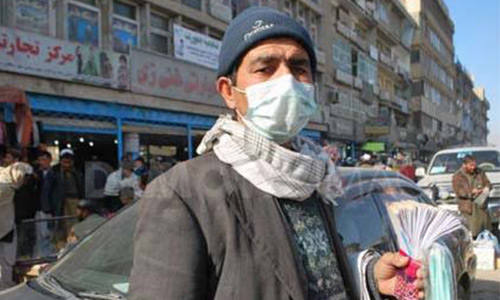From smog hanging over cities to smoke inside the home, air pollution poses a major threat to health and climate. Air pollution specifically outdoor air pollution which is also known as ambient air pollution can be defined as the presence of toxic chemicals and compounds (including those of biological origin) in the air which are usually not visible to the naked eye and which lower the quality of the air or causes detrimental changes to the quality of life while that can threaten human’s health and well-being. According to the World Health Organization, Air pollution kills around seven million people worldwide every year (WHO).
The most populated city of Afghanistan, Kabul has almost 6 million population and with the wake of everyday air pollution is rising health problems to inhabitants of this city. According to WHO Regional Office for the Eastern Mediterranean, ambient air pollution (outdoor) in Kabul City causes over 11000 deaths annually (WHO 2016 stats), Furthermore, according to the State of Global Air, more than 26,000 Afghan deaths could be attributed to pollution in 2017. The United Nations Assistance Mission in Afghanistan documented nearly 3,500 civilian casualties from the war for the same time period. Moreover, at least 17 people died of respiratory infections in the last week of December 2019 in Kabul and due to hazardous levels of air pollution more than 8,800 patients visited government hospitals, suffering from health conditions, including lung problems.
Air pollution is a seasonal concern of Kabul residents, incineration of low-quality fuels (non-filtered coal, plastics, waste, tier scrap…) as well as heavy industry and old unmaintained vehicles are the main roots of the Kabul air contamination. According to AirVisual, an organization that ranks the world’s cities according to an Air Quality Index (AQI), indicates that Kabul city’s pollution hits the peak in autumn and winter seasons, months from October to February are worst. During these five months, AQI levels increase phenomenally, implying very poor air quality. Now the big question pops out, Is there any solution to the Kabul’s Air Pollution problem? What measurements do officials need to take to stop air contamination? Which pollutants and sources should be targeted? With the growth of population and poverty, Kabul city surely needs a series of long term planning while as things are going right now Kabul Inhabitants definitely needs an Immediate solution.
The establishment of the 3 main units in the body of the National Environmental Protection Agency (NEPA) can be the key solution to the above-mentioned problem, units like Emergency smoke control unit (ESCU), Transportation emission control unit (TECU) and Environmental Networking Unit (ENU), can be helpful to be there, Speaking of the first unit which is Emergency smoke control unit (ESCU), we can summarise it’s functionality by establishment of an environmental monitoring team responsible for monitoring all environmental related issues and complaints like inspection of Kabul city’s residential buildings, factories, and industries with authority of ceasing factories and heating systems (if standards no reached), and other pollution sources, for example ceasing of Brick Kilns (when AQI reaches 150), sanctioning of Non-Filtered coal supplying in the market place, and Temporary shutting down of heavy Industries and factories (when AQI reaches 150) can be mentioned.
Furthermore, transportation vehicles are one of the major categories of air pollutants in Kabul city which needs to be addressed, the Transportation emission control unit (TECU) can take measures (when immediate actions are required to be taken) like banning the entry or movement of all 20 years old vehicles, while implementation of Odd-even schemes for all private vehicles in Kabul city can be extremely useful, on the other hand posing heavy penalties on any unauthorized parking, and providing funds for encouragement of public transportation like utilizing buses can be named, in order to discourage private vehicles use in Kabul City which can play an enormous role in reduction of air pollution.
The Environmental Networking Unit (ENU) can play a significant role in this whole scenario, and this unit is responsible for networking with all governmental and non-governmental organizations, for instance, we can indicate to United Nation’s Environmental Program (UNEP), Kabul Minicipility, Ministry of Public Health (MOPH), Ministry of Industries and Commerce (MOCI), Ministry of Energy and water (MEW), Ministry of Urban Development and land (MUDL), and The Administrative office of the president (AOP), for further exemplification this unit can reduce the LPG (liquid petroleum gas) price with the help of MOCI, as well as can redce electricity load shedding with the collaborative movement with MEW, whereas this unit can completely put restrictions on waste incineration and ensure that all wastes are collected and managed in a standardized manner in collaboration with Kabul Municipility, moreover this unit can request to MUDL in order to practice a ban over constructional activities and it’s demolition (when AQI reaches 200), in conclusion, this unit can send a request to the administrative office of the prisedent to announce a complete emergency shut down of all schools, universities, firms and governmental authorities when AQI exceeds 300 (Extremely hazardous).
To summarize air pollution control has remarkable effects on public health, life quality, and economic growth of the country, and we need to address it, in a comprehensive manner, because the victims of this phenomenon is not less than the victims of the war we are suffering from, and even it could rise to a catastrophic level in the future.
Home » Opinion » The Solution for Kabul’s Diseased Lungs
The Solution for Kabul’s Diseased Lungs
| Sayed Sameer Sadat

